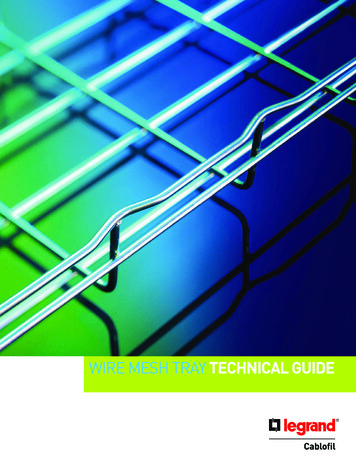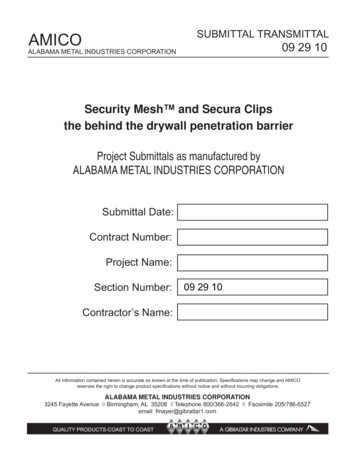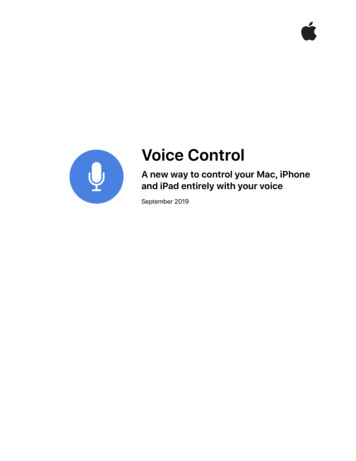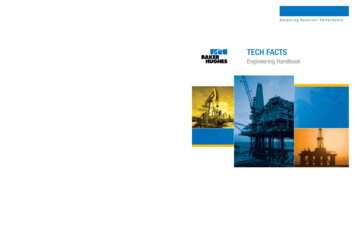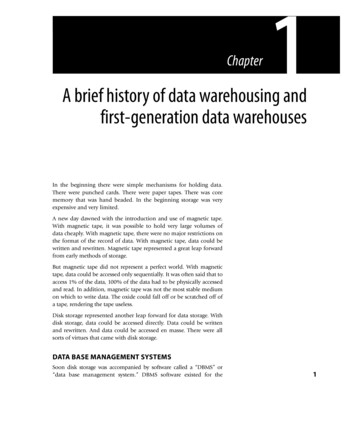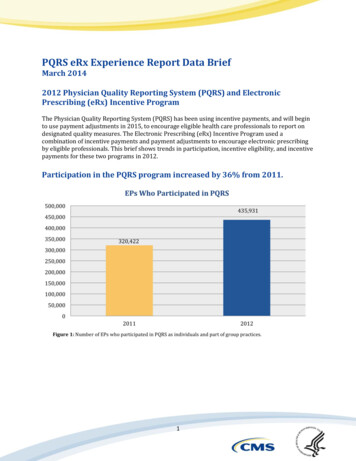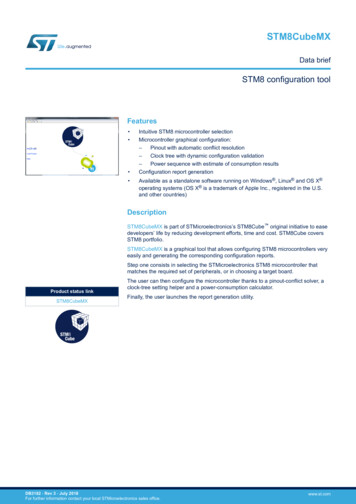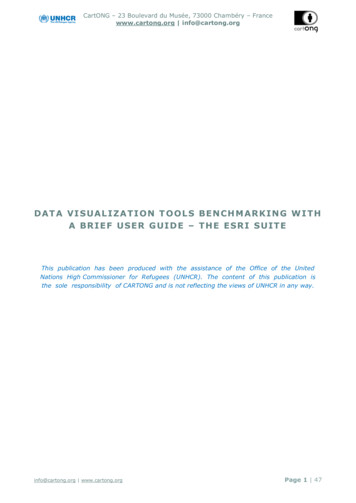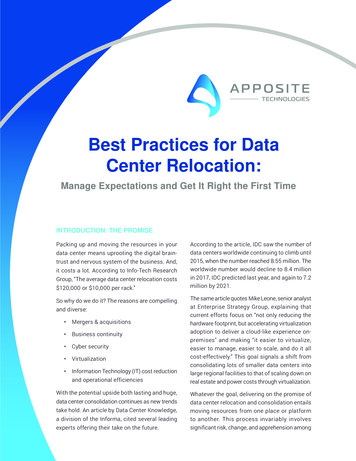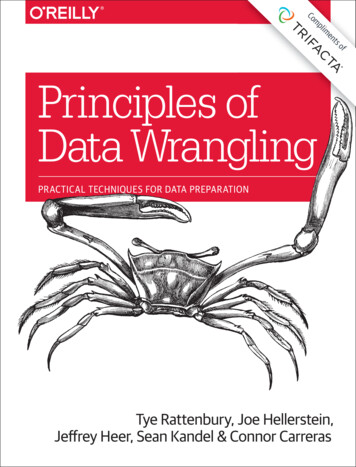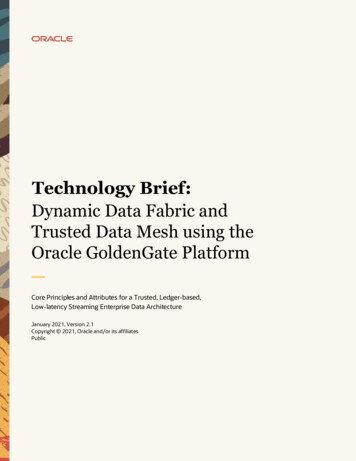
Transcription
Business / Technical BriefTechnology Brief:Dynamic Data Fabric andTrusted Data Mesh using theOracle GoldenGate PlatformCore Principles and Attributes for a Trusted, Ledger-based,Low-latency Streaming Enterprise Data ArchitectureJanuary 2021, Version 2.1Copyright 2021, Oracle and/or its affiliatesPublic1Dynamic Data Fabric and Trusted Data Mesh using the Oracle GoldenGate PlatformCopyright 2021, Oracle and/or its affiliates Public Document
DisclaimerThis document is for informational purposes only and is intended solely to assistyou in planning for the implementation and upgrade of the product featuresdescribed. It is not a commitment to deliver any material, code, or functionality,and should not be relied upon in making purchasing decisions. Thedevelopment, release, and timing of any features or functionality described inthis document remains at the sole discretion of Oracle. Due to the nature of theproduct architecture, it may not be possible to safely include all featuresdescribed in this document without risking significant destabilization of the code.Document PurposeThe intended audience for this document includes technology executives andenterprise data architects who are interested in understanding Data Fabric, DataMesh and the Oracle GoldenGate streaming data platform. The document’sorganization and content assume familiarity with common enterprise datamanagement tools and patterns but is suitable for individuals new to OracleGoldenGate, Data Fabric and Data Mesh concepts.The primary intent of this document is to provide education about (1) emergingdata management capabilities, (2) a detailed enumeration of key attributes of atrusted, real-time Data Mesh, and (3) concise examples for how OracleGoldenGate can be used to provide such capabilities.This paper applies to Oracle Cloud and also to multi-cloud enterpriseenvironments.2Dynamic Data Fabric and Trusted Data Mesh using the Oracle GoldenGate PlatformCopyright 2021, Oracle and/or its affiliates Public Document
Table of contentsExecutive Summary4A Dynamic Data Fabric for Enterprise Needs5Oracle Concept of a Trusted Data Mesh5GoldenGate as a Bridge to Fabric / Mesh6A Time for ChangeModel Crisis: The Data Monolith88Why Now? Enabling Technologies12Key Objectives and Tangible Benefits14New Paradigm for Data Architecture16Foundation: Data Product Thinking17Principle #1: Decentralized, Modular Mesh17Principle #2: Enterprise Data Ledgers18Principle #3: Trusted, Polyglot Data Streams19Dynamic Data Fabric, Deployed as a Trusted Mesh21Data Product Thinking21Aligning Operational and Analytic Data Stores24Enterprise Event Ledger25Decomposition of the Data Monolith27Data Domains and Data Zones28What Makes a Mesh a Mesh30Key Personas, Role of Self-Service32Continuous Transformation and Loading (CTL) Data Pipelines33Repeatable Data Product Factories34Manufacturing Agility with DevOps, CI/CD, and DataOps36Security and Governance in a Data Mesh37Oracle GoldenGate: Trusted Bridge to a Data Mesh43Data Products Provided by GoldenGate44Microservices, Cloud-Native Architecture48Data Fabric and Data Mesh Patterns Enabled by GoldenGate49Microservices Transaction Outbox, CQRS and Event Sourcing50World-class Stream Processing52Dynamic Data Fabric and Trusted Data Mesh with Oracle CloudHigh Level Blueprints5455Conclusion – Get Ready for Change57References603Dynamic Data Fabric and Trusted Data Mesh using the Oracle GoldenGate PlatformCopyright 2021, Oracle and/or its affiliates Public Document
Executive SummaryBusiness transformation initiatives are being held back by outdated thinking about data and an oldergeneration of monolithic data tools. Modern enterprise data estates are becoming more decentralizedand multi-cloud, data entropy is unavoidably increasing over time. To achieve businesstransformation goals, business teams need freely streaming, well governed data.Monolithic data architectures, whether in-cloud or on-premise, will not deliver the necessarymodularity and speed required for business success. By bringing together new thinking and moderntechnologies, Dynamic Data Fabric and Trusted Data Mesh are set to provide a new path forward thatwill unlock more value from the enterprise data estate. Adopting this new approach will empowerfaster innovation cycles and lower cost of data operations as a result of smarter automation andfewer complexities in the data supply chain.All enterprise scale businesses have a data estate. Hundreds or even thousands of applications, data stores, data lakesand analytics may run the business or drive decision-making across many lines of business. Market winners will bethose enterprises that succeed at driving more value from their data estate by disrupting existing markets andcreating new opportunities. Successful digital transformation initiatives are rooted in sound strategy and excellentexecution (ie; people and process), but technology has always had a very important role to play in cr eating newefficiencies, powering new innovations, and opening up new opportunities.Dynamic Data Fabric and Trusted Data Mesh offer an entirely different and better approach for enterprises to buildand govern their data estates. This new approach is a new kind of enterprise data architecture that prioritizes dataproduct thinking, fully embraces the decentralization of data, and is built to preserve trusted, correct data within realtime streaming data platforms. An industry trusted Data Fabric foundation is core, with a focus on dynamic,streaming data and value-based data product management. Data Mesh concepts are also a central aspect of theapproach, but with a technical foundation that can ensure data consistency, correctness, and trust.This new kind of data architecture will empower faster innovation cycles and lower costs of operations. Evidence fromearly adopters and pioneers of this approach indicate significant large-scale benefits that are possible today: Total clarity into data’s value chain – through applied ‘data product thinking’ best practices 99.999% operational data availability – using microservices based data pipelines for replication 10x faster innovation cycles – shifting away from ETL, to continuous transformation and loading (CTL) 70% reduction in data engineering – using no-code and self-serve data pipeline toolingIt is indeed a rare opportunity to find a solution that can work equally to reduce costs associated with ongoingoperations while also powering up innovation for the business units working to use data as a competitive advantage –this is one of those moments.4Dynamic Data Fabric and Trusted Data Mesh using the Oracle GoldenGate PlatformCopyright 2021, Oracle and/or its affiliates Public Document
A Dynamic Data Fabric for Enterprise NeedsFirst popularized in the early 2000’s the Data Fabric was initially most associated with in -memory object grids. ThenForrester began writing about more general data fabric solutions and by 2013 the Data Fabric became a full-fledgedresearch category i. The concept of a Data Fabric has become pervasive, and Gartner has even declared that “DataFabric Is the Future of Data Management”ii. Today, the Data Fabric topic applies to a wide set of data technologies.Generally, there is consensus that there is no single tool that encompasses the full breadth of a Data Fabric. Rather,for organizations that adopt a data fabric, it is a design concept that spans many ‘styles’ of data integration andgovernance to achieve a harmonized and cohesive solution. Forrester’s definition is that a Data Fabric “delivers aunified, intelligent, and integrated end-to-end platform to support new and emerging use cases. The sweet spot is itsability to deliver use cases quickly by leveraging innovation in dynamic integration, distributed and multicloudarchitectures, graph engines, and distributed in-memory and persistent memory platforms. Data fabric focuses onautomating the process integration, transformation, preparation, curation, security, governance, and orchestration toenable analytics and insights quickly for business success.”iiiOracle is an independently recognized iv leader in the Data Fabric and the full portfolio includes:CLOUD-NATIVE, COMMON PLATFORM DATA FABRICBEST-OF-BREED DATA FABRIC FOR MULTI-CLOUD & ON-PREMISE Self-Service ETL for Analytics & Autonomous DB Oracle Data Integrator (w/ETL, Quality, Messaging) OCI Data Catalog, OCI Data Integration, OCI Data Flow Oracle GoldenGate and Stream Analytics OCI GoldenGate and Stream Analytics for OCI Oracle Big Data SQL (Data Federation) Integration Cloud and Oracle Cloud SQL Oracle Data Visualization (Data Preparation)Within the Oracle portfolio, the Oracle GoldenGate platform is distinctly focused on the concept of a dynamic DataFabric – focusing on real-time replication, streaming, time series analytics and in-memory data processing fordecentralized, multi-cloud ecosystems.Oracle Concept of a Trusted Data MeshThe term ‘Data Mesh’ has been used as far back as the 1990’s in reference to 3D laminates and digital microscopy vand by the early 2000’s the term appeared as a way of explaining how TCP/IP networks work vi. In the context of datamanagement in the late 2000’s, we see Data Mesh first become more common in papersvii describing the earlySemantic Web initiatives such as the Web Ontology Language (OWL) and Resource Description Framework (RDF).Around this time, in 2007, there is also an informal “Data Mesh” wiki definition referencing “a network for routingdata from any point to any other point [ ] across heterogeneous networks that are active only intermittently”viii.More recently, the concept of a Data Mesh for enterprise data was noted in a 2016 Gartner report “Maverick*Research: Revolutionizing Data Management and Integration With Data Mesh Networks”ix. Then, in 2019 theThoughtWorks paper “How to Move Beyond a Monolithic Data Lake to a Distributed Data Mesh”x has reanimated theconcept as it began to catch on more broadly.As you can see, there are different sources for the origin of the Data Mesh term, but for the purposes of thisdocument we will be using the ThoughtWorks paper as the most recent point of reference. In that paper, the case ismade that “the data mesh platform is an intentionally designed distributed data architecture, under centralizedgovernance and standardization for interoperability, enabled by a shared and harmonized self-serve datainfrastructure.” A principal focus of the Data Mesh is to place emphasis on ‘domain data products’ as a first-classconcern and to promote the decentralization of data using ‘immutable data sets’ as products.The heritage and DNA of this new conceptualization of a data mesh stems from Microservices design-thinkingconcepts such as Domain-driven Design (DDD) and Event Sourcing. ThoughtWorks leadership (Martin Fowler, et al)have been long-time leaders in distributed software, Agile development, and Microservices mesh design patterns. It is5Dynamic Data Fabric and Trusted Data Mesh using the Oracle GoldenGate PlatformCopyright 2021, Oracle and/or its affiliates Public Document
this heritage of thinking that have informed some of the best aspects (de-centralization, monolith decomposition,data product thinking, etc) of their framing of Data Mesh, but it also leads to some substantial blind-spots (eventualconsistency, dependency on developer heuristics, physics of data management at petascale) as well.In this document, the Oracle definition builds on prior definitions of Data Mesh and goes further to emphasizeelements of strong data consistency (trusted data transactions), governance and verifiability of data (data validation)and enterprise-scale demands (peta-scale data movement on mission-critical data). In this converged definition, atrusted Data Mesh is a data architecture approach focused on outcomes (data products), IT agility in a multicloud world (mesh), trusted data of all kinds (polyglot data streams), and faster business innovation cycles(using event-driven data ledgers).Of all the words which could have been chosen to describe a Data Mesh, the word ‘mesh’ is familiar, emotive anduniquely fits the bill. Like other technology ‘meshes’ that you are familiar with (eg; WiFi Mesh, Smart Home Mesh, 5GMesh, Service Mesh/Kubernetes etc) a recurring and central attribute of Data Mesh is the archetype of a networked,de-centralized architecture. At core, the mesh is about rejecting centralized monolithic architectures.There are many other crucial attributes of a Data Mesh that we discuss in this document, but it is this “mesh’iness”that is core to understanding the technological break from the past and why this new approach better prepares us fora future where all applications, services and analytics are inherently distributed and multi-cloud.GoldenGate as a Bridge to Fabric / MeshA San Francisco startup founded in the 1990’s, GoldenGate’s original purpose was to provide business continuity anddata high availability for networked ATM/cash machines running from Tandem NonStop databases.Figure 1: GoldenGate platform capabilitiesToday Oracle GoldenGate software still provides business continuity and data high availability for databases likeNonStop, DB2 iSeries, LUW and mainframes, SQL Server and GoldenGate is also the pinnacle of the Oracle DatabaseMaximum Availability Architecture ‘Platinum Tier’ service level. Many thousands of global banks, retailers, telecoms,healthcare companies etc. run their operational data platforms on the trust foundation of Oracle GoldenGate.At core, GoldenGate is a real-time data replication tool that can detect data events and route them across networks atvery low latencies. The GoldenGate technology is used for geographic sharding of operational databases, lowdowntime data migrations, multi-active (online) data stores, real-time data ingestion to cloud, data lakes, and datawarehouses etc. Since 2015 GoldenGate has been increasingly focused on polyglot big data and noSQL datapayloads and has been completely refactored for native Microservices ‘as a service’ deployments.6Dynamic Data Fabric and Trusted Data Mesh using the Oracle GoldenGate PlatformCopyright 2021, Oracle and/or its affiliates Public Document
In 2018 the GoldenGate platform added Data Pipelines and Stream Analytics with a robust complex event processing(CEP) core engine that scales to billions of events per second while preserving ordered data processing down to thenano-second scale. This event engine can use very powerful semantics for transformations or analytics and runs onan open-source Apache Spark for massively parallel processing (MPP).With these new capabilities, GoldenGate provides high-value data products directly to data consumers. In the past,GoldenGate would have mainly been used to deliver low-latency raw data to data pipelines or other data products.Today, GoldenGate can push raw data as well as provide high-value data products.DATA PRODUCTS PROVIDED BY GOLDENGATEDATA PRODUCTS POPULATED BY GOLDENGATE Data Pipelines & Streaming Data Services Data Marts or OLAP/ROLAP Analytics Time Series Analytics and Production ML/AI Scoring Data Lakes and Cloud Analytics Geo-Spatial Alerting and Real-time Dashboards Doc, KVP, Search and Graph Data StoresFigure 2: Creating and populating data products with GoldenGateGoing forward, business leaders will require more streaming data, more real-time events, greater data availability, andstrong governance for transactions. Trusted data fabrics must preserve a strong data consistency from the datasource-of-truth all the way to any downstream data lake or analytics tooling that may consume the data. GoldenGateis a proven, trusted Data Fabric platform to make the pivot into a Data Mesh future.What’s next? In the remainder of this document, we will diver deeper into the following: A Time for Change – explore the outmoded thinking and cultural changes that must change, and evaluatenext-gen tech innovations that are the springboard for this new data architecture approach Principles of the New Paradigm – succinctly summarize the 4 key principles: Data Product Thinking,Decentralized Mesh Networking, Enterprise Data Ledgers, Polyglot Data Streams Dynamic Data Fabric as a Trusted Data Mesh – deep dive into attributes and characteristics of what makesa Data Fabric dynamic, and how a Data Mesh can provided trusted, 100% consistent data streams 7Explainer for Oracle GoldenGate – mapping the product characteristics of existing GoldenGate technologiesinto the Dynamic Data Fabric and Trusted Data Mesh patternsDynamic Data Fabric and Trusted Data Mesh using the Oracle GoldenGate PlatformCopyright 2021, Oracle and/or its affiliates Public Document
A Time for ChangeAfter 35 years of preeminence, centralized and monolithic data architectures are ripe for change. As with anysoftware pattern that has remained relevant for multiple decades, we can certainly say that the monolithic dataarchitecture has been successful. In fact, so successful that all enterprise IT organizations no doubt already run manydata monoliths in production. These data monoliths may include batch ETL tools, Operational Data Stores (ODS),Enterprise Data Warehouses (EDW), and Data Lakes on-premises or in a public cloud.For more than 35 years the Data Monolith has been the dominant paradigm of thinking forenterprise data architecture and now that paradigm is about to change.In the wider software development ecosystem, the winds of change have already been blowing. Widespread adoptionof Microservices and Service Mesh (Kubernetes et al.) architecture has been directly a result of the desire to movebeyond the classical software monoliths of the past. Business and developer desires for greater agility, modularity,change tolerance and faster innovation cycles have created a sea-change in the way enterprise software is written.In the data world, monolithic data architectures have many of the same fundamental characteristics (of monolithicapplications) which now block important improvements necessary for data modernization and businesstransformation. Attributes of classical data management monoliths include:TREAT DATA AS AN IT ARTIFACTData is treated as a byproduct of the application functions, requiring the semantics of domain modelingto be done and re-done many times in the IT lifecycleMONOLITHIC AND CENTRALIZEDHub-and-spoke style architecture dominates the IT ecosystem, but each App, ETL, Mart, Warehouse,Lake etc presumes itself to be the center of the data landscape, thereby requiring IT to constantly fundprojects that integrate and align data using incompatible toolsWATERFALL DATAOPS / DEVOPSIn the “data landscape” of databases, ETL, Marts, Warehouse, Lakes etc etc there remains a strong biastowards waterfall-style operations, the Agile methodologies of development haven’t been able to providea repeatable CI/CD lifecycle approach across the monolithsBATCH PROCESSING CENTRICMovement of data for most Analytic (OLAP) domains remains predominantly batch-oriented to bedriven by the scheduler (clock) rather than the events of the business itselfOLTP VS. OLAP (DECOUPLED)Different operational applications (OLTP) and analytics (OLAP) are often separated organizationally,politically, and technically – causing IT friction (delays), data domain semantic issues (reduced datatrust), and least-common-denominator solutions (low innovation)Changes in classical tooling and architecture design are necessary and important, but perhaps more importantly,there is also a need for widespread paradigmatic change in thinking about the intrinsic value of data. Increasingly,some business leaders are already thinking about data as an asset. In fact, data is a kind of capital. This isn’t ametaphor like “data is the new oil” or “data is the new gold”. Data fulfills the literal, economic textbook definition ofcapital. Capital is a produced good, not a natural resource. You have to invest to create it, not just dig
Within the Oracle portfolio, the Oracle GoldenGate platform is distinctly focused on the concept of a dynamic Data Fabric – focusing on real-time replication, streaming, time series analytics and in-memory data processing for decentralized, multi-cloud ecosystems. Oracle
